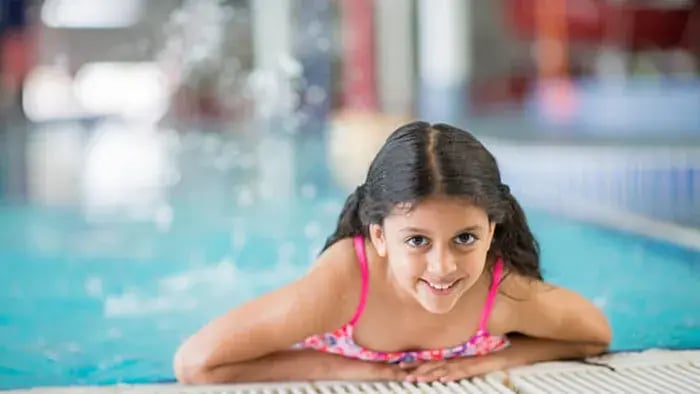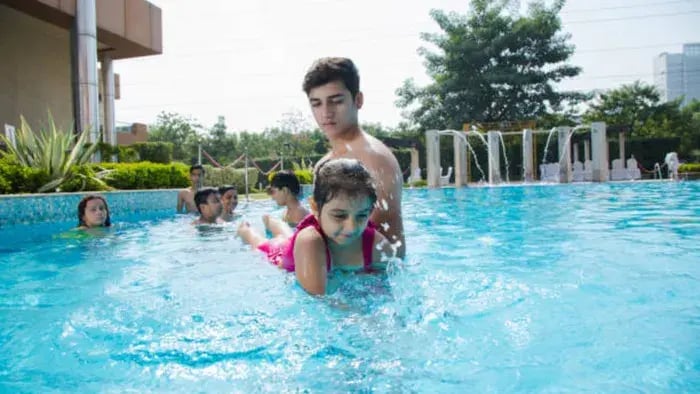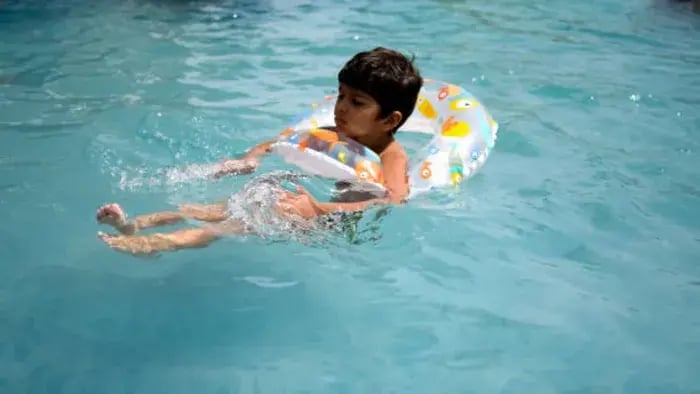- Treasure Hunt
- Red Light, Green Light
- Motorboat Game
- Ring Toss
- Shark and Minnows
- Bubble Blowing Contest
- Follow the Leader
- Floating Starfish
- Ping Pong Ball Push
Introduction
It takes time to help your child feel confident in the water, but it doesn’t have to be all serious lessons and drills. With the right mix of fun and creativity, swimming can become something your child looks forward to, especially when it’s play. According to a study in, Front Psychiatry. 2022, swimming games are a great way to introduce water skills in a relaxed and happy way. They bring out smiles and laughter and build comfort, coordination, and confidence in the pool.

Many children feel unsure when learning to swim, especially if they’re new to the water. Games are a gentle way to help them move, float, and breathe without fear. Whether it’s diving for toys, chasing floating objects, or pretending to be sea creatures, playful water activities keep kids engaged while they gradually improve their swimming skills.
Even simple games like “Ring Catch”, “Treasure Hunt” or “Red Light, Green Light” can teach breath control, paddling, and body balance, all while keeping it light and pressure-free. These games are suitable for all levels, from beginners to children who are just starting to swim independently. With a bit of imagination, a swimming session becomes an adventure, making your child more relaxed, responsive, and ready to enjoy the water with confidence.
9 Fun Swimming Games for Kids That Improve Water Confidence

Introducing your child to the water can be both exciting and a little nerve-wracking, especially if they’re new to swimming or a bit hesitant. The good news is that building water confidence doesn’t have to feel like a formal lesson. Swimming games can turn nervous splashes into happy giggles, helping your child enjoy the water at their own pace. These games encourage basic swimming skills, such as kicking, floating, breath control, and coordination, all while maintaining a playful and pressure-free atmosphere.
Treasure Hunt
Drop waterproof toys or sinkable rings into shallow or mid-depth areas of the pool. Ask your child to dive or reach down to collect them one by one. This game teaches underwater breath control, builds comfort with submersion, and encourages movement in all directions.
Red Light, Green Light
Your child swims or walks when you say "green light" and freezes when you say "red light." It’s a fun way to teach them to control their movement, slow down, and become more aware of their surroundings in the water. It’s also great for improving focus and listening skills.
Motorboat Game
Hold your child under the arms while they lie back and kick their legs, pretending to be a motorboat. You can even make engine noises together. This game builds leg strength, improves body position, and gives them confidence with floating.
Ring Toss
Toss floating rings into the pool and ask your child to throw soft balls or smaller rings to land inside them. It teaches hand-eye coordination, arm movement, and controlled balance in the water. You can also float the rings further to make it more challenging.
Shark and Minnows
In this game, one player is the “shark” and the others are “minnows.” The minnows swim across the pool without getting tagged. It encourages fast swimming, breath control, and playful risk-taking—all while building group bonding and confidence.
Bubble Blowing Contest
Sit together in the shallow end and blow bubbles through your mouths or noses. Make it a contest to see who can blow the most or the longest bubbles. This game reduces fear of getting water on the face and teaches the basic technique for learning to breathe while swimming.
Follow the Leader
Take turns being the leader and doing simple pool moves like arm circles, big kicks, spins, or blowing bubbles. This game is especially useful for beginners, as it helps them mimic swim techniques without realizing they’re learning. It also adds a fun, creative twist to each session.
Floating Starfish
Ask your child to lie back with arms and legs spread like a starfish and float. Hold them gently if needed and encourage deep breaths. Floating helps reduce the fear of sinking, rebuilds strength, and improves balance. Celebrate small wins—just a few seconds of floating counts.
Ping Pong Ball Push
Give your child a ping pong ball and ask them to push it across the pool using only their breath. This helps them control exhalation, stay low in the water, and focus on gentle movements—all functional for early swim strokes.
Conclusion

Swimming games are a playful way to help your child feel safe and confident in the water. By combining fun with simple movements, they naturally develop skills such as breath control, balance, and coordination. With regular play and gentle encouragement, your child can enjoy the water while learning to swim with ease.
Her love for storytelling began with reading her grandfather’s speeches, where Tarishi saw the power of words in creating lasting memories. Combining her passions for food and writing, she has turned her life into a fulfilling path of sharing stories that celebrate flavours and how food brings communities together.
The views expressed are that of the expert alone.
The information provided in this content is for informational purposes only and should not be considered a substitute for professional medical advice, diagnosis, or treatment. Always seek the advice of your physician or another qualified healthcare provider before making any significant changes to your diet, exercise, or medication routines.
















